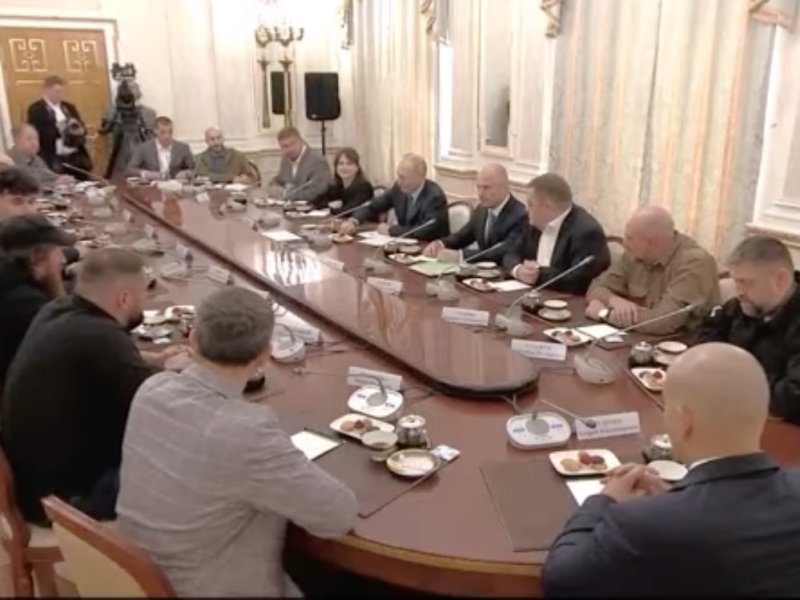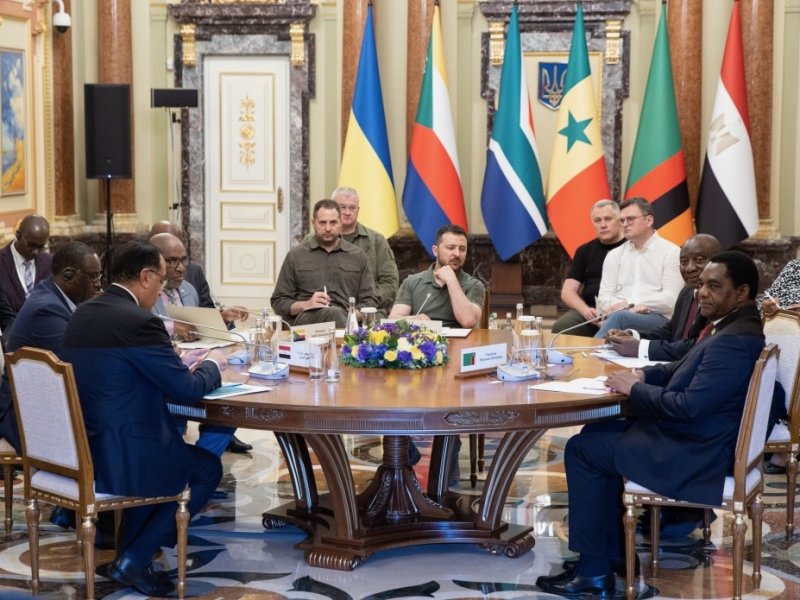It’s a fool’s game. Kiev’s communication asserts that its army launched a counter-offensive two weeks ago. But this does not correspond to what can be seen on the battlefield. It also claims to welcome with hope the two missions of good offices from China and the African Union. But Volodymyr Zelensky has interrupted the negotiations he was conducting with Moscow and enacted a law prohibiting their resumption.

According to the authorities in Kiev, the Ukrainian army launched "a vast counter-offensive against the Russian aggressor" on June 8.
There’s no such thing as a counter-offensive
Military literature prefers to speak of a counter-attack rather than a counter-offensive. A counter-attack consists in taking advantage of the enemy’s momentary weaknesses to launch an assault. We think of Napoleon at Austerlitz, who had some of his troops beaten back in order to trap his adversaries, from which he emerged victorious.
Choosing the term "counter-offensive" is not neutral. It’s a communication device suggesting that the Russians have launched an "offensive" to seize Ukraine. In fact, they fought at the capital’s northern airport before withdrawing.
In reality, the Russians have never attempted to take Kiev and have no intention of invading Ukraine. That’s what their president, Vladimir Putin, said in the first week of his "special operation". Taking a military airport, even one north of Kiev, is just a battle to give the Russians air superiority. It does not indicate that they intended to take the capital.
The term "special operation" is not neutral either. Moscow is stressing that it is not waging a war of invasion, but is implementing its "responsibility to protect" the populations of the Donetsk and Lugansk oblates, who had officially been the targets of a punitive operation by Kiev, since 2014. To question the validity of the Russian special operation would be like questioning the French army’s operation to put an end to the massacres in Rwanda. Both special operations were authorized by resolutions of the United Nations Security Council (resolutions 929 of June 22, 1994 and 2202 of February 17, 2015). Except that the resolution on which Moscow is relying was not taken in a hurry. It is the one that endorses the Minsk agreements and gives Germany, France and Russia the ability to intervene to enforce them.
From a communications point of view, the term "counter-offensive" has the advantage of making us forget that for eight years, Kiev waged a war against its own citizens, killing between 14,000 and 22,000 people, depending on the count.
For months, Kiev begged for and obtained a large quantity of Western weapons. It also trained its soldiers to handle them. Meanwhile, Moscow fell back on the lines it had accepted during the peace negotiations, conducted in Belarus and then Turkey, before being denounced by the Verkhovna Rada (the Kiev parliament in which Washington has installed an office of permanent advisors from the State Department and USAID). Moscow went further, abandoning the right bank of Kherson (but not the left), making the Dnieper River the natural border between Ukraine and Novorossia. The inhabitants of this region having joined the Russian Federation by referendum, Moscow built two defense lines, stretching from the mouth of the Dnieper to the Donbass (Lugansk and Donetsk). These are two lines of dragons’ teeth (fortifications preventing the passage of armoured vehicles) and trenches.
The Atlantic Alliance, which is providing the weapons and strategies, has given the order to launch the counter-offensive at a time when Kiev has no control over the air and little ammunition. During the previous year, the Ukrainian army was able to use drones to monitor its adversary’s movements. Today, it can no longer do so, as the latter jams all communications on "its" territory and a little beyond. In theory, Kiev has an impressive array of land-based weaponry, the likes of which no country has ever had. In practice, however, many of the weapons delivered have disappeared, bound for other climes, with or without the agreement of the generous donors. As for ammunition, it cannot be stored in Ukraine without being destroyed by Russian hypersonic missiles. They are also warehoused in Poland and Moldavia, crossing the border only to reach the front line.
For two weeks, Ukrainian forces have been trying to break through Russian defensive lines, but without success. The troops are amassing in front of these lines and are being fired on by Russian artillery. When they decide to withdraw, the Russians send drones scattering mines on their way home.
The only thing Kiev’s forces can do is take the villages that lie a few kilometers in front of the defense lines. Meanwhile, enemy aircraft are bombing their arsenals, sometimes deep inside Ukraine. The most effective anti-aircraft protection systems, the Patriots, were destroyed as soon as they were installed. There’s not much left, just enough to reach old missiles. The Ukrainian General Staff claims to have destroyed six Kinzhal missiles, which, given their speed (10 mach), is impossible. The mayor of Kiev, Vitali Klitschko, released a photograph of himself posing in front of a Kinzhal wreckage. Unfortunately, the wreckage does not correspond at all to this weapon.
Morale among Ukrainian troops is at an all-time low. The Ministry of Defense assures us that there are plenty of men left in the rear. However, the Ivano-Frankivsk oblast has decreed the mobilization of all men aged 18 to 60. Exemptions are rare. The reality therefore seems to be that there are no combatants left ready for action.
The Atlantic Alliance has deployed all its AWACS to remotely monitor the battlefield. It cannot ignore the scale of the defeat. Strangely, it continues to push the Ukrainians into battle, or rather, into death.

Kiev doesn’t want a good offices mission
Washington still hopes that Kiev will win, giving President Joe Biden a resounding re-election. It could, however, back down and rely on the two good offices missions of China and the African Union. However, at Washington’s urging, the Verkhovna Rada has forbidden anyone to negotiate with the “invader”.
China has published 12 principles which it believes should underpin any peace agreement. Beijing’s special envoy, Li Hui, refuses to discuss their implementation until they have been approved by both parties. This has now been done. But Westerners are not fooled. We can only pretend to share these principles by continuing the lies we have been developing for three decades. Otherwise, they will lead us to recognize the validity of Russia’s position, and thus to wish for Kiev’s defeat.
The African Union and Fondation Brazaville have sent four heads of state. Azali Assoumani (Comoros and current President of the African Union), Macky Sall (Senegal), Cyril Ramaphosa (South Africa) and Hakainde Hichilema (Zambia). All the others failed to show up. Egypt’s President sent his Prime Minister, Mostafa Madbouly. Uganda’s Yoweri Museveni, suffering from Covid, sent his former Minister of Foreign Affairs, Ruhakana Rugunda. Congo’s Denis Sassou-Nguesso was represented by Florent Ntsiba, Minister of State at the Presidency.
On arrival, the entire delegation was invited to visit Boutcha, where their hosts explained that the Russian occupiers had committed atrocities. The Africans did not meet the international investigators who established, on the contrary, that the massacres had been perpetrated with darts; (ammunition widely used during the First World War). Above all, the Russians left Boutcha on March 30, 2022. The local mayor saw nothing unusual. Then, the following day, the full nationalists of the Azov battalion entered the town but the bodies weren’t found till April 4. Clearly, then, this was a scene of civil war, in which the Integral Nationalists executed fellow citizens they believed to have collaborated with the Russians. In any case, Africans know all about such situations and are not easily fooled.
When they arrived in Kiev, the sirens went off. But these leaders were not impressed. They saw that the capital had not been bombed, but only a few military targets.
During the final press conference, Comorian President Azali Assoumani declared: "The path to peace must involve respect for the United Nations Charter, and Africa is ready to continue working with you in the search for lasting peace (...) Even if the road to peace may be long, there is hope that talks are possible". To which Ukrainian President Volodymyr Zelensky replied: "Today I made it clear during our meeting that allowing any negotiations with Russia now, when the occupier is on our land, means freezing the war, freezing the pain and suffering.
After this rejection, the Africans travelled to Saint Petersburg to meet Russian President Vladimir Putin. Of course, Putin was far more forthcoming. Not only did he have nothing to lose, he also had a massive argument in his favor. He presented the delegation (see video) with the text of the peace treaty and addendum negotiated by the Ukrainians in March 2022, and signed by the head of their delegation. He even explained that, in application of this project, Russian troops had left the oblasts of Kiev and Chernihiv, and that the Ukrainians had not only refused to ratify these texts, but had adopted a law prohibiting the continuation or resumption of peace negotiations.
It remains to be seen, at the Africa-Russia summit scheduled for July 26-29, which of the two heads of state will have appeared more sincere in the eyes of the African Union delegation. Kiev’s interest in missions of good offices is as false as its counter-offensive.

 Articles by this author
Articles by this author Send a message
Send a message





























Stay In Touch
Follow us on social networks
Subscribe to weekly newsletter